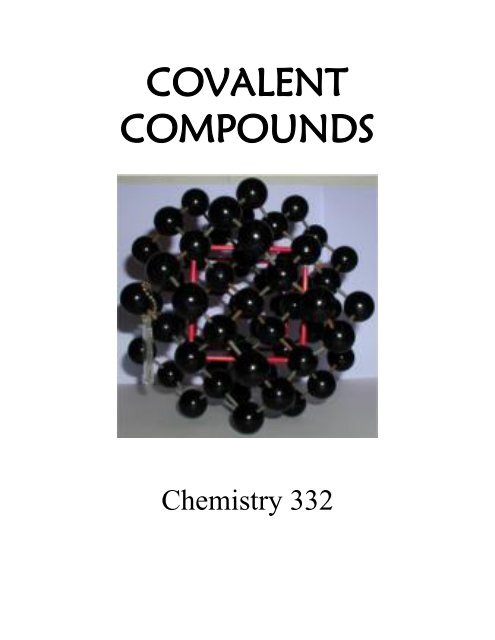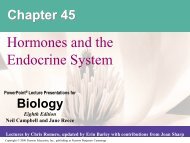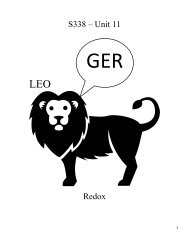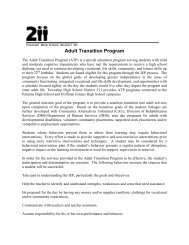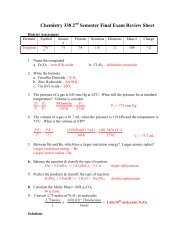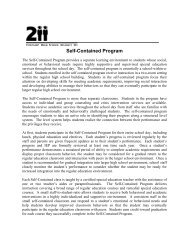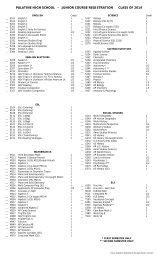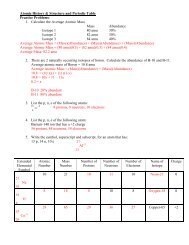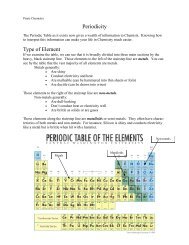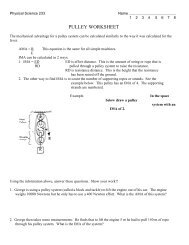for covalent compounds or ions
for covalent compounds or ions
for covalent compounds or ions
Create successful ePaper yourself
Turn your PDF publications into a flip-book with our unique Google optimized e-Paper software.
COVALENT<br />
COMPOUNDS<br />
Chemistry 332
Unit 4 (Covalent Compounds)<br />
1. Write the electron dot structure (Lewis Dot Structure) <strong>f<strong>or</strong></strong> <strong>covalent</strong> <strong>compounds</strong> <strong>or</strong> <strong>ions</strong>.<br />
2. Use electronegativity to determine the polarity of a bond <strong>or</strong> molecule.<br />
3. Given the <strong>f<strong>or</strong></strong>mula of a <strong>covalent</strong> compound, write its c<strong>or</strong>rect name; given the name of a<br />
<strong>covalent</strong> compound, write its <strong>f<strong>or</strong></strong>mula.<br />
4. Describe the attractive <strong>f<strong>or</strong></strong>ces between <strong>ions</strong>, polar molecules, and nonpolar molecules.<br />
Unit 4 (Covalent Compounds)<br />
Covalent Bond, Octet Rule, Lewis Dot Structure/Intramolecular Bond, Intermolecular F<strong>or</strong>ce,<br />
Polar, Non-polar, Solubility<br />
2
COVALENT COMPOUNDS<br />
Covalent <strong>compounds</strong> are made from two non-metals and so don’t follow the n<strong>or</strong>mal ionic<br />
rules. You can tell if a compound is <strong>covalent</strong> because it has prefixes modifying the<br />
species names. These species tell you exactly how many atoms are in the <strong>covalent</strong><br />
compound.<br />
The prefixes are<br />
1 = mono<br />
2 = di<br />
3 = tri<br />
4 = tetra<br />
5 = penta<br />
6 = hexa<br />
7 = hepta<br />
8 = octa<br />
9 = nona<br />
10 = deca<br />
All you have to do is write the species in the compound together, and add a subscript based on<br />
the numbers above:<br />
nitrogen dioxide: NO 2<br />
dinitrogen monoxide: N 2 O<br />
phosph<strong>or</strong>us pentachl<strong>or</strong>ide: PC1 5 sulfur hexaflu<strong>or</strong>ide: SF 6<br />
diphosph<strong>or</strong>us pentoxide: P 2 O 5<br />
Most <strong>or</strong>ganic <strong>compounds</strong> that contain alcohol (R-OH) <strong>or</strong> carboxylic acid (R-<br />
COOH) functional groups will most likely be soluble due to the hydrogen<br />
bonding capabilities of those substances. Other <strong>covalent</strong> <strong>compounds</strong> tend to be<br />
insoluble in water.<br />
Most <strong>or</strong>ganic and <strong>covalent</strong> <strong>compounds</strong> will not conduct electricity in water.<br />
The exception to this rule are <strong>or</strong>ganic acids (carboxylic acids).<br />
3
Chemistry 332<br />
Name ______________________<br />
I. Name the following <strong>compounds</strong>.<br />
Covalent Naming<br />
1. N 2 O 5 _____________________________________________________________________________________<br />
2. SeBr 6 _________________________________________________________<br />
3. CH 4 __________________________________________________________<br />
4. C 6 H6 _____________________________________________________________________________________<br />
5. PF 6 __________________________________________________________<br />
6. BF 3 __________________________________________________________<br />
7. P 2 l 4 __________________________________________________________<br />
8. S 2 Cl 3 _________________________________________________________<br />
9. NO 2 __________________________________________________________<br />
10. P 2 O 5 _________________________________________________________<br />
11. OF 2 __________________________________________________________<br />
12. CO __________________________________________________________<br />
13. BrO 3 _________________________________________________________<br />
14. BN __________________________________________________________<br />
15. CBr 4 _________________________________________________________<br />
4
II. Please write the <strong>f<strong>or</strong></strong>mulas the <strong>f<strong>or</strong></strong>mulas <strong>f<strong>or</strong></strong> the following <strong>compounds</strong>.<br />
1. Dihydrogen monoxide ________________________________________________<br />
2. Phosph<strong>or</strong>us trihydride _________________________________________________<br />
3. Dinitrogen trioxide ___________________________________________________<br />
4. Carbon tetrachl<strong>or</strong>ide __________________________________________________<br />
5. Carbon dioxide ______________________________________________________<br />
6. Trinitrogen tetroxide __________________________________________________<br />
7. Dinitrogen monoxide __________________________________________________<br />
8. tetraphosph<strong>or</strong>us decaoxide ______________________________________________<br />
9. Selenium trioxide _____________________________________________________<br />
10. Iodine heptaflu<strong>or</strong>ide __________________________________________________<br />
11. Sulfur hexaflu<strong>or</strong>ide ___________________________________________________<br />
12. Sulfur dichl<strong>or</strong>ide _____________________________________________________<br />
13. Disilicon hexabromide ________________________________________________<br />
14. Dichl<strong>or</strong>ine heptaoxide _________________________________________________<br />
15. Pentaphosph<strong>or</strong>us decoxide ______________________________________________<br />
5
Chemistry 332<br />
Name ___________________________<br />
1. Name the following <strong>compounds</strong>.<br />
Covalent Compounds<br />
AsF 5 OF 2 TeF 4<br />
CCI 4 CO H 2 Se<br />
PH 3 SeO 2 PI 3<br />
2. Write the <strong>f<strong>or</strong></strong>mulas <strong>f<strong>or</strong></strong> the following <strong>compounds</strong>.<br />
Disulfur dichl<strong>or</strong>ide<br />
nitrogen trihydride<br />
Silicon tetroxide<br />
nitrogen dioxide<br />
Arsenic tribromide<br />
tetraphosph<strong>or</strong>us hexoxide<br />
diphosph<strong>or</strong>us pentoxide<br />
sulfur dioxide<br />
carbon tetrabromide<br />
disulfur pentoxide<br />
6
Chemistry 332<br />
Name ______________________________<br />
Modeling Lewis Dot Structures<br />
Direct<strong>ions</strong>: Complete the missing in<strong>f<strong>or</strong></strong>mation on the data table below. Construct a<br />
model <strong>f<strong>or</strong></strong> any <strong>compounds</strong> that have an asterisk (*) next to their name. The key<br />
below will designate the appropriate col<strong>or</strong> <strong>f<strong>or</strong></strong> ach element.<br />
Element<br />
Hydrogen<br />
Carbon<br />
Oxygen/sulfur/selenium<br />
Nitrogen<br />
Halogens<br />
Col<strong>or</strong><br />
white<br />
black<br />
red<br />
blue<br />
green (small)<br />
Chemical Name F<strong>or</strong>mula Valance<br />
Electrons<br />
# of<br />
Dashes<br />
Lewis Dot Structure<br />
Carbon dioxide CO 2 C – 4 O - 12 8 O = C = O<br />
ammonia<br />
*<br />
methane<br />
*<br />
propane<br />
*<br />
hydrochl<strong>or</strong>ic acid<br />
*<br />
ethane<br />
*<br />
NH 3<br />
CH 4<br />
C 3 H 8<br />
HCl<br />
C 2 H 4<br />
carbon tetrachl<strong>or</strong>ide<br />
*<br />
bromine gas<br />
*<br />
PBr 3<br />
7
Lewis Dot Structures<br />
(Side 2)<br />
Direct<strong>ions</strong>: Completer the data table below. It is not necessary to construct any models.<br />
F<strong>or</strong>mula<br />
Valance<br />
Electrons<br />
# of<br />
Dashes<br />
Lewis Dot Structure<br />
NCl 3<br />
SiS 2<br />
HSiN<br />
CF 2 Cl 2<br />
GeH 4<br />
CSF 2<br />
SeCl 2<br />
AsF 3<br />
C 2 Br 2<br />
Cl 2<br />
H 2 O<br />
CH 2 O<br />
CF 4<br />
8
Name _____________________________<br />
Lewis Dot Structures W<strong>or</strong>ksheet #1<br />
Homew<strong>or</strong>k Problems<br />
1. CO 2 2. H 2 O<br />
3. H 2 CO 4. HI<br />
5. NH 3 6. HCCH<br />
7. CH 4 8. CH 2 F 2<br />
9. SeF 2 10. HCN<br />
9
Name ____________________________<br />
Lewis Dot Structures W<strong>or</strong>ksheet #2<br />
Homew<strong>or</strong>k Problems<br />
1. HC1 2. C1CN<br />
3. CS 2 4. H 2 S<br />
5. N 2 6. Br 2 CCBr 2<br />
7. NI 3 8.O 2<br />
9. CF 4 10. H 3 COH<br />
10
Lewis (Electron) Dot F<strong>or</strong>mulas – 5 Easy Rules<br />
1. Determine Arrangement – Place the least electronegative atom in the<br />
center. The halogens and hydrogen can never be in the center.<br />
2. Determine total number of valence electrons. Two electrons are<br />
represented by one dash.<br />
(add <strong>f<strong>or</strong></strong> negative <strong>ions</strong>, subtract <strong>f<strong>or</strong></strong> positive <strong>ions</strong>)<br />
3. Attach central atom to surrounding atoms. Molecule should be<br />
symmetrical.<br />
4. Distribute remaining electrons.<br />
5. Use double <strong>or</strong> triple bonds if necessary. Hydrogen and the halogens<br />
can never have a double <strong>or</strong> triple bond.<br />
11
Table of Electronegativity Values<br />
1 A 2 A 3 A 4 A 5 A 6 A 7 A 8 A<br />
H<br />
He<br />
2.1<br />
Li Be B C N O F Ne<br />
1.0 1.5 2.0 2.5 3.0 3.5 4.0<br />
Na Mg Al Si P S Cl Ar<br />
0.9 1.2 1.5 1.8 2.1 2.5 3.0<br />
K Ca Ga Ge As Se Br Kr<br />
0.8 1.0 1.6 1.8 2.0 2.4 2.8<br />
Rb Sr In Sn Sb Te I Xe<br />
0.8 1.0 1.7 1.8 1.9 2.1 2.5<br />
Cs Ba Tl Pb Bi Po At Rn<br />
0.7 0.9 1.8 1.9 1.9 2.0 2.2<br />
Fr<br />
0.7<br />
Ra<br />
0.9<br />
Differences in Electronegativity<br />
Covalent Non-polar = 0 – 0.4<br />
Covalent Polar = 0.5 and above<br />
Ionic = Contains a metal<br />
12
B6polar<br />
Name ____________________________<br />
Polarity w/s<br />
Given the molecules below, identify those which are polar and which are nonpolar. Then identify<br />
which ones <strong>f<strong>or</strong></strong>m hydrogen bonds with like molecules.<br />
13
Name ________________________________<br />
Investigating Some Properties of Water<br />
A water molecule is <strong>f<strong>or</strong></strong>med when two hydrogen atoms are bonded to a single oxygen<br />
atom. Because of the structures of the atoms involved, a bent molecule is <strong>f<strong>or</strong></strong>med.<br />
H<br />
O<br />
H<br />
The bond between each hydrogen and the oxygen atom is <strong>f<strong>or</strong></strong>med by the sharing of a pair<br />
of electrons. The electrons are not shared equally between the two atoms. The oxygen atom has<br />
greater attraction <strong>f<strong>or</strong></strong> the shared pair of electrons so it keeps them closer to itself. The unequal<br />
sharing causes the oxygen atom to have a partial negative charge (δ-) while the hydrogen atoms<br />
will have a partial positive charge (δ+).<br />
Because the partially negative oxygen and partially<br />
positive hydrogen’s are arranged in a bent shape,<br />
the water molecule has a positive side and a<br />
negative side; it is called a polar molecule <strong>or</strong><br />
dipole.<br />
This polarity causes the water molecules to be attracted to each other. The positive side of<br />
one molecule is attracted to the negative side of another molecule.<br />
This intermolecular attraction (shown by the<br />
lighter lines) is weaker than the <strong>covalent</strong> bonds<br />
which hold the hydrogen and oxygen atoms<br />
together in each molecule, but is strong enough<br />
to affect the properties of water.<br />
In this lab you will investigate some properties of water by comparing water’s behavi<strong>or</strong> to that of<br />
hexane in several situat<strong>ions</strong>. Hexane is a non polar molecule because of the very uni<strong>f<strong>or</strong></strong>m<br />
arrangement of the atoms in the molecule.<br />
Hexane<br />
14
Name ____________________________<br />
Investigating Some Properties of Water PLW<br />
1. Draw the molecular structure of water and label the partial charges of each element.<br />
2. Why is the water molecule’s shape bent and not linear?<br />
3. How does the shape of the water molecule determine its polarity?<br />
4. Define hydrogen bonding.<br />
5. Using class notes, describe intermolecular bonds.<br />
6. Draw the structure of hexane and describe its polarity.<br />
15
Name ___________________________<br />
Water & Cyclohexane Lab Quest<strong>ions</strong><br />
Table 1: Rate of evap<strong>or</strong>ation<br />
Explain in detail why the drop of cyclohexane evap<strong>or</strong>ated faster than the drop of water.<br />
Table 2: Capillary action<br />
Explain in detail why the water went further up the glass capillary tube than did cyclohexane.<br />
Table 3: Surface Tension<br />
Explain in detail why you were able to put m<strong>or</strong>e drops of water than cyclohexane on a penny.<br />
Table 4: Wax Paper<br />
Explain in detail why the water and cyclohexane behaved as they did on wax paper.<br />
16
Table 5: Static Charge<br />
Explain in detail why the water was bent by static charge but the cyclohexane wasn’t.<br />
Table 6: V<strong>or</strong>tex<br />
Explain in detail why the cyclohexane was easier to make a v<strong>or</strong>tex in than water.<br />
Table 7: Surface tension<br />
Explain in detail why a paperclip can float on top of water but not on top of cyclohexane.<br />
17
Lab- Covalent Solubility<br />
Purpose- The purpose of this lab is to develop a series of solubility guidelines <strong>f<strong>or</strong></strong> <strong>covalent</strong><br />
<strong>compounds</strong>.<br />
Safety:<br />
Goggles and Aprons must be w<strong>or</strong>n<br />
Procedure-<br />
1. Fill 7 test tubes ¾ full with tap water.<br />
2. Using the small bottles provided, add 10 drops of each chemical to a test tube.<br />
3. Put a stopper on each test tube and shake <strong>f<strong>or</strong></strong> 30 seconds.<br />
4. Let the contents of the tube settle and examine each tube.<br />
5. Make a determination if the substance dissolved in the water <strong>or</strong> not.<br />
6. Rec<strong>or</strong>d your results in the data table.<br />
7. Dispose of the chemicals as instructed by your teacher.<br />
Data-<br />
Substance<br />
Methanol<br />
Cyclohexane<br />
Ethyl acetate<br />
Acetic acid<br />
Ethanol<br />
Toluene<br />
Ethylene glycol<br />
Dissolves in water?<br />
Explanation-<br />
Come up with a guideline <strong>f<strong>or</strong></strong> the solubility of these <strong>compounds</strong> in water. You should<br />
complete the statements:<br />
A substance will dissolve in water if…<br />
18
H<br />
H C O<br />
H<br />
H<br />
Methanol<br />
H H<br />
H H<br />
H C C<br />
H<br />
C C<br />
H<br />
H C C<br />
H H<br />
H H<br />
Cyclohexane<br />
H<br />
H<br />
O<br />
H<br />
H<br />
O<br />
H<br />
C C O<br />
H H<br />
C<br />
C<br />
H<br />
H<br />
H<br />
C C O<br />
H<br />
H H<br />
Ethyl acetate<br />
Acetic Acid<br />
H<br />
H H<br />
C C<br />
H H<br />
Ethanol<br />
O<br />
H<br />
H<br />
C<br />
H<br />
H<br />
C C<br />
C C<br />
C<br />
H<br />
H<br />
H<br />
H<br />
C<br />
H<br />
Toluene<br />
H<br />
H<br />
O<br />
H<br />
C<br />
H<br />
C<br />
H<br />
O<br />
H<br />
Ethylene glycol<br />
19
Intramolecular Bonds<br />
(Bonds within a compound)<br />
Type Definition Electronegativity<br />
Difference<br />
Ionic<br />
Examples<br />
Diagram<br />
Covalent<br />
Polar<br />
Electronegatvity<br />
Difference is .5 <strong>or</strong><br />
greater<br />
Covalent<br />
Non-Polar<br />
Electronegativity<br />
Difference is less<br />
than .5<br />
20
Intermolecular Bonds<br />
(Bonds between two <strong>compounds</strong>)<br />
Type Definition Examples Drawing<br />
Hydrogen<br />
Dipole-<br />
Dipole<br />
Dispersion<br />
aka<br />
London<br />
F<strong>or</strong>ces<br />
21
Evap<strong>or</strong>ation and Intermolecular Attract<strong>ions</strong><br />
In this experiment, Temperature Probes are placed in various liquids. Evap<strong>or</strong>ation occurs<br />
when the probe is removed from the liquid’s container. This evap<strong>or</strong>ation is an endothermic<br />
process that results in a temperature decrease. The magnitude of a temperature decrease is related<br />
to the strength of intermolecular <strong>f<strong>or</strong></strong>ces of attraction. In this experiment, you will study<br />
temperature changes caused by the evap<strong>or</strong>ation of several liquids and relate the temperature<br />
changes to the strength of intermolecular <strong>f<strong>or</strong></strong>ces of attraction. You will examine the molecular<br />
structures <strong>f<strong>or</strong></strong> the presence and relative strength of two intermolecular <strong>f<strong>or</strong></strong>ces—hydrogen bonding<br />
and dispersion <strong>f<strong>or</strong></strong>ces.<br />
PRE-LAB SET UP<br />
Obtain six test tubes, each with a different chemical. Set #1 should contain: Ethylene<br />
Glycol, Ethanol, and Cyclohexane. Set #2 should contain: Methanol, water, and Acetone. You<br />
should also have a Vernier logger-pro green box with three different temperature probes attached<br />
to it. Be sure you know which temperature probe is plugged into which slot.<br />
CHEMICAL STRUCTURES<br />
The chemical structures of the six chemicals to be used in this experiment are shown<br />
below.<br />
22
PROCEDURE<br />
1. Obtain and wear goggles! CAUTION: The <strong>compounds</strong> used in this experiment are flammable<br />
and poisonous. Avoid inhaling their vap<strong>or</strong>s. Avoid contacting them with your skin <strong>or</strong> clothing.<br />
Be sure there are no open flames in the lab during this experiment. Notify your teacher<br />
immediately if an accident occurs.<br />
2. Prepare the computer <strong>f<strong>or</strong></strong> data collection<br />
• Prepare the computer <strong>f<strong>or</strong></strong> data collection by opening the experiment file. Go to: Start<br />
My computer Extras on P files (O drive) Science Chemistry 332 Lab-<br />
Evap<strong>or</strong>ation<br />
• On the Graph window, the vertical axis has temperature scaled from 5 to 30 º C. The<br />
h<strong>or</strong>izontal axis has time scaled from 0 to 250 seconds.<br />
3. Wrap the three probes with pieces of paper towels of similar size secured by small rubber<br />
bands as shown in Figure 1. Roll the filter paper around the probe tip in the shape of a<br />
cylinder. Hint: First slip the rubber band up on the probe; wrap the paper around the probe,<br />
and then finally slip the rubber band over the wrapped paper. The paper should be even with<br />
the probe end.<br />
4. Stand probe 1 in the Ethylene Glycol tube, probe 2 in the Ethanol tube, and probe 3 in the<br />
Cyclohexane tube.<br />
5. Prepare 3 pieces of masking tape to be used to tape the probes in position during Step6.<br />
6. After the probes have been in the liquids <strong>f<strong>or</strong></strong> at least 45 seconds, begin data collection by<br />
clicking (•COLLECT) Monit<strong>or</strong> the temperature <strong>f<strong>or</strong></strong> 15 seconds to establish the initial temperature of<br />
each liquid. Then simultaneously remover the probes from the liquids and tape them so the<br />
probe tips extend 5 cm over the edge of the table top as shown in Figure 1.<br />
7. When both temperatures have reached minimums and have begun to increase, click ( • STOP )<br />
to end data collection.<br />
8. Roll the rubber band up the probe shaft and dispose of the paper towels and rubber bands in<br />
the trash can.<br />
9. Print out the results of your experiment and label each line by putting the c<strong>or</strong>rect name of the<br />
substance by its c<strong>or</strong>responding line on the graph.<br />
10. Examine the structures of the three substances and decide what kind of intermolecular <strong>f<strong>or</strong></strong>ces<br />
are present in each, dispersion <strong>f<strong>or</strong></strong>ces <strong>or</strong> hydrogen bonding.<br />
11. Using this in<strong>f<strong>or</strong></strong>mation, make a prediction of the shape of the graph <strong>f<strong>or</strong></strong> chemical set #2. Decide<br />
which line will be which chemical base upon the structures.<br />
12. Repeat the experiment but this time use chemical set #2: methanol, water, and acetone.<br />
13. Print out the results of you experiment and label the three lines with the c<strong>or</strong>rect names of the<br />
substances.<br />
23
Name ______________________________<br />
PLW Evap<strong>or</strong>ation and Intermolecular Attract<strong>ions</strong><br />
Substance F<strong>or</strong>mula Structural F<strong>or</strong>mulas Molecular<br />
Weight<br />
Hydrogen Bond<br />
(Yes <strong>or</strong> No)<br />
Cyclohexane C 6 H 12<br />
Acetone<br />
C 3 H 6 O<br />
Substance F<strong>or</strong>mula Structural F<strong>or</strong>mulas Molecular<br />
Weight<br />
Hydrogen Bond<br />
(Yes <strong>or</strong> No)<br />
Water<br />
Ethylene<br />
Glycol<br />
H 2 O<br />
C 2 H 4 (OH) 2<br />
Substance F<strong>or</strong>mula Structural F<strong>or</strong>mulas Molecular<br />
Weight<br />
Methanol CH 3 (OH)<br />
Hydrogen Bond<br />
(Yes <strong>or</strong> No)<br />
Ethanol<br />
C 2 H 5 (OH)<br />
1. Is evap<strong>or</strong>ation an endothermic <strong>or</strong> exothermic process?<br />
2. Define evap<strong>or</strong>ation by describing the molecules movement.<br />
24
Analysis of Evap<strong>or</strong>ation Lab<br />
Set #1<br />
Substance<br />
Electron Dot<br />
Structure<br />
Polar<br />
Or<br />
Nonpolar<br />
Type of<br />
Intermolecular<br />
Bond<br />
# of H<br />
Bonds<br />
Ethylene<br />
Glycol<br />
Ethanol<br />
Cyclohexane<br />
25
Analysis of Evap<strong>or</strong>ation Lab<br />
Set #2<br />
Substance<br />
Electron Dot<br />
Structure<br />
Polar<br />
Or<br />
Nonpolar<br />
Type of<br />
Intermolecular<br />
Bond<br />
# of H<br />
Bonds<br />
Methanol<br />
Water<br />
Acetone<br />
26
TIE DYE PATTERNS<br />
There are endless ways of getting patterns on your shirts. The first time you do this, you<br />
will want to give students some ideas. However, you will find that student become very<br />
creative and do things that we never thought about. I highly recommend that they do use<br />
patterns though rather than trying to write on shirts. The writing spreads and the shirts<br />
are usually not liked by the students the next day.<br />
(1) SPIRALS – Spread shirt out front side up. Grasp wherever you would like the center of<br />
spiral and carefully twist keeping the shirt flat. Your shirt will look like a pie shape. Now<br />
use bamboo skewers sticks and rubber bands to bind together. Be careful that the center of<br />
the spiral is not in a place you do not desire (like the center of your tummy, etc.) Squirt on<br />
dye like you are cutting a pie. You may do one col<strong>or</strong> perhaps 8 ways and then take another<br />
col<strong>or</strong> in the white areas in between. I recommend that you col<strong>or</strong> all visible white <strong>f<strong>or</strong></strong> a<br />
striking shirt. You will always have some white where the folds are. Turn over and<br />
REPEAT.<br />
(2) MULTI-SPIRALS –You may make as many spirals as you desire. Again be careful<br />
where you choose. Two in breast area usually are not acceptable to young ladies. You may<br />
make each spiral different col<strong>or</strong>s, etc. Get creative. Do both sides.<br />
(3) SPIDERS – Many of the students enjoy spiders with black (heavy metal types). Fold<br />
shirt in half lengthwise so that the back of shirt is to inside. Now grasp the shirt about 1/3<br />
of the way from the neck and make a spiral. Place col<strong>or</strong> on in pie shapes and then place<br />
BLACK dye on the other white areas (pie shape). Turn over and repeat on back side.<br />
(4) STRIPES – Fold shirt in half and fold acc<strong>or</strong>dion folds. If you want a V effect, place at<br />
45 º angle from neck. Squirt on dye perpendicular to folds. Bind together with rubber bands<br />
and sticks. Do not leave white unless you want a lot of white in your shirt.<br />
(5) FIRE – Grab pieces of shirt and twist bands around the areas.<br />
(6) CRINKLE – Lay shirt flat on table. Fluff up areas <strong>or</strong> grasp. Sprinkle dye on areas in<br />
pattern you like. This pattern is difficult to bind together with rubber ands and sticks but<br />
can be done.<br />
(7) STAR – This is m<strong>or</strong>e complicated, but very nice when finished. Lay the damp shirt on<br />
surface. Smooth out wrinkles. Fold in half so sleeves match. Fold back one side on the<br />
quarter line. Fold sleeve up. Turn shirt over and fold on quarter line on other side and fold<br />
sleeve up. Straighten out so you now have a long rectangle. You will now do a flag fold.<br />
(Have you ever folded a flag?) You will end up with a compact triangle. Your triangle has<br />
two sides equal and a longer side. Place your sticks on the two c<strong>or</strong>ners and bind with<br />
rubber bands. Now take your 1 st dye col<strong>or</strong> and squirt on all three c<strong>or</strong>ners. Make sure that<br />
you get enough so the dye permeates all folds. Then take a 2 nd col<strong>or</strong> and place on three<br />
sides. Let sit <strong>f<strong>or</strong></strong> 24 hours.<br />
27


